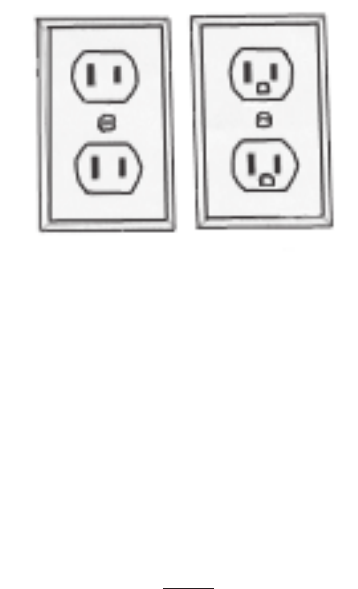
SKU 92426 For technical questions, please call 1-800-444-3353 Page 6
3. Your tool must be plugged into an
appropriate outlet, properly installed and
grounded in accordance with all codes and
ordinances. The plug and outlet should look
like those in the following illustration.
(See Figure A.)
DOUBLE INSULATED TOOLS:
TOOLS WITH TWO PRONG
PLUGS
4. Tools marked “Double Insulated” do
not require grounding. They have a special
double insulation system which satisfies
OSHA requirements and complies with the
applicable standards of Underwriters Laboratories, Inc., the Canadian Standard
Association, and the National Electrical Code. (See Figure B.)
5. Double insulated tools may be used in either of the 120 volt outlets shown in the
following illustration. (See Figure B.)
EXTENSION CORDS
1.
Grounded
tools require a three wire extension cord.
Double Insulated
tools can use
either a two or three wire extension cord.
2. As the distance from the supply outlet increases, you must use a heavier gauge
extension cord. Using extension cords with inadequately sized wire causes a serious
drop in voltage, resulting in loss of power and possible appliance damage.
(See Figure C, below.)
3. The smaller the gauge number of the wire, the greater the capacity of the cord. For
example, a 14 gauge cord can carry a higher current than a 16 gauge cord.
(See Figure C.)
4. When using more than one extension cord to make up the total length, make
sure each cord contains at least the minimum wire size required. (See Figure C.)
5. If you are using one extension cord for more than one appliance, add the nameplate
amperes and use the sum to determine the required minimum cord size.
(See Figure C.)
6. If you are using an extension cord outdoors, make sure it is marked with the suffix
“W-A” (“W” in Canada) to indicate it is acceptable for outdoor use.
7. Make sure your extension cord is properly wired and in good electrical condition.
Always replace a damaged extension cord or have it repaired by a qualified electrician
before using it.
8. Protect your extension cords from sharp objects, excessive heat, and damp or wet
areas.
Figure B











